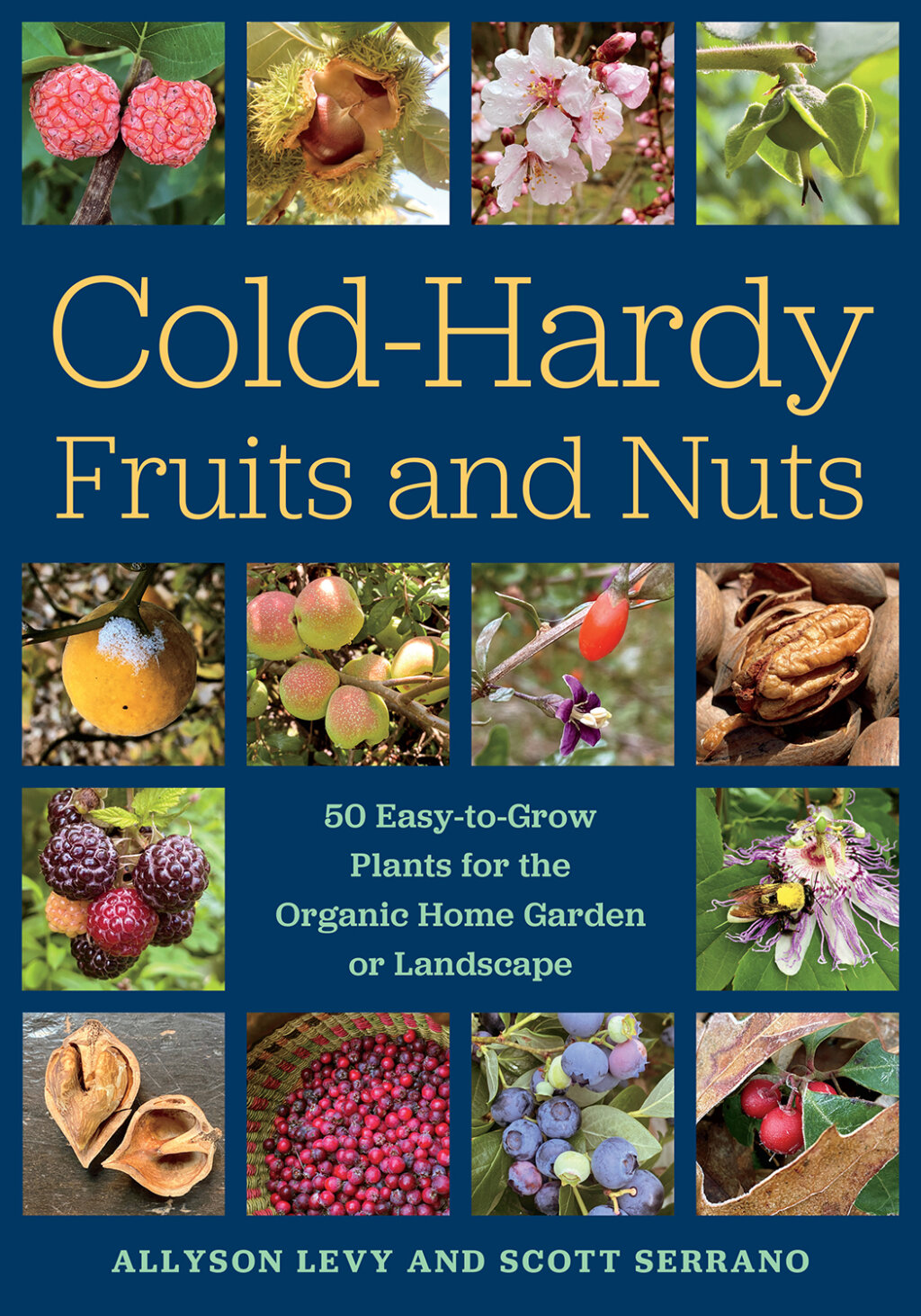BOOK REVIEW BY PAM DAWLING
ADDENDUM 7/27/22: Since writing this review I have heard that some of the plants that are not invasive in New York’s Hudson Valley are invasive elsewhere, so if you have any doubt at all, please check with your local Extension Service.
This book is a delight for the landscaper, plantsperson, and fruit connoisseur. Here are profiles of 50 fruits and nuts, almost certainly including at least one or two you haven’t heard of. Che, akibia, medlar, schisandra. . . they are all resilient, low-maintenance cold-hardy plants for growing in temperate zones. And growing trees is, as Eric Toensmeier points out “one of the world’s highest-carbon forms of gardening and farming.â€
The authors are the founders of the Hortus Arboretum and Botanical Gardens in New York’s Hudson Valley, a garden they created to provide inspiration for their work in visual arts. As the garden grew to 11 acres, their main passion evolved into growing and selling ornamental and edible plant collections with a focus on underutilized species, and sharing their gardens with the public through classes and open days.
Cold-Hardy Fruits and Nuts does not include apples, peaches, and other popular fruits that are actually a challenge to grow sustainably (although pears are included). This book assumes you will find basic cultivation advice from some other source, and instead focuses on specific details about each plant that you might not have seen anywhere else. The authors’ goal is to increase diversity for reasons of climate resilience and support for insect species.
The plant profiles include taste ratings, recommended cultivars, propagation methods, requirements for soil, sun, shade and fertilization, and notes on harvesting and eating; also a Growth Difficulty Rating alerting readers to the level of attention (low, lower and lowest!) that the plants will require once established. The crops in this book are disease-resistant and pest-resistant. Many of the plants have a photo page with bark, blossom, leaves and fruit at various stages of development. The fascinating plant descriptions and natural histories will keep you entranced on rainy days. I found myself wishing for a calendar of fruiting dates, to plan year-round fruit. Although not presented in that format, the information is in each Taste Profile and Uses section.
The first fruit is akebia, also known as chocolate vine. It is an attractive ornamental, and if you want fruit, you need two genetically different plants. Akebia is easy to grow and thrives on neglect. It could be invasive, although the authors have not found it so. The 3-5†(7.5-13cm) fruit look like purple sausages with a waxy bloom. When ripe, the fruits split open showing white pulp enclosing tiny black seeds. The taste is like coconut-flavored tapioca pudding.
The second plant is the familiar almond. If you have disease problems with peaches, plums or cherries, think twice. If you have room for a few large trees, consider growing a few Dunstan blight-resistant chestnuts, and helping the restoration of the great American chestnut. Or plant pecans, choosing varieties suited to your location. Wait up to ten years for nuts.
Walnuts (black and English, as well as hybrids like heartnuts butternuts, buartnuts) need a long-term plan. All walnut trees produce the compound juglone in all parts of the tree. This compound is allelopathic – it inhibits the growth of nearby plants, both edible and ornamental – so give them a space of their own. Hazelnuts grow more shrub-like if American, more of a small tree if European. Eastern filbert blight can be a problem with European hazelnuts, but not American ones.
The Korean Stone Pine or Chinese Pine Nut thrives on steep slopes and thin soils. The trees do grow tall, looking from a distance like American White Pines. Although self-fertile, they provide higher yields if two trees are planted. The cones take two years to mature, and are covered with a very sticky resin. Store them in bags until the scales separate. The seeds in their shells look like small pistachios.
Asian pears are easy to grow and the usual pear disease and pest problems (fire blight and codling moth) affect them less. Shipova is a hybrid of the European pear with the whitebeam mountain ash, propagated by grafts. The fruits are 1.5-2†(4-5 cm) and stay green for a long time before ripening to a blushing yellow. It can take ten years before any fruit is available. Usually the flavor is sweet, delicate and fragrant.
Quinces are tree fruits closely related to pears, and were more popular in the past. The Pilgrims brought quince seeds from northern Europe, and it was the only source of fruit pectin until the end of the nineteenth century. Watch out for fire blight and cedar apple rust. The fruit is hard and downy, and cannot be eaten raw. The easiest way to cook them is to bake them whole, when they become fragrant and delicious. The authors didn’t have this information, and instruct on peeling and de-seeding before cooking, which is slow work. Cooking whole and making jelly is another option. Older varieties of flowering quince also produce fruit, but in modern varieties that feature has been bred out and double-flowering has been bred in! A few of the fruiting varieties include Crimson and Gold, Jet Trail, Tanechka, and Toyo-Nishiki which all grow as shrubs, not trees.
Medlars are another ancient old world fruit, with not much modern-day interest. The fruits are not edible until “bletted†by a hard frost or by waiting beyond normal ripeness, when they get very close to rotting. The small trees have beautiful spring blossoms, and if you don’t harvest the fruit, they remain on the twigs during the winter, giving added interest then. They can also be eaten frozen during winter walks through the orchard.
American Persimmons really must ripen on the tree to be good eating. They don’t need a frost, but they do need to be soft, with a golden-orange to red-orange skin. Harvest the fallen ones each morning from late September until the end of November.
Beach plums grow wild on the east coast from North Carolina upwards, and while they are easy to grow, the quality of the small stony fruits varies. Nanking cherry is a short shrub producing small bright red (or white) cherries that can be used for pies. They fall from the bush when ripe, and need to be gathered and used soon, as they do not have a shelf life. The flowering shrub is very attractive.
There are some (relatively) hardy citrus, such as the trifoliate orange, a very thorny tree with small sour fruits, useful for marmalade and fruit sauces. The trees are very good for hedges and Flying Dragon makes a spectacular winter sight with snow on the twisted branches.
Jujubes are also known as Chinese dates or red dates. They are easy-care trees once established, ripening in mid-late fall if in full sun. If left to dry, the fruit gains a date-like texture. Two trees are required for cross-pollination, choosing varieties that have flowers opening at the same time of day. They can survive cold winters, provided the summer is long and hot.
Pawpaws have earned themselves several books of their own in recent years. Although tropical flavored, this fruit is adapted to temperate zones, and needs 400 chilling hours below freezing in order to flower. They are slow to reach fruiting age, but then are easy to maintain. The large oblong fruit contain several large seeds and a soft custard-like flesh. They can be eaten out of the skin with a spoon, or they can be frozen to eat later, like ice cream. Don’t eat the skins, and don’t eat cooked pawpaws. Two different trees are needed together for cross-pollination. There are myths about which insects pollinate pawpaws, but the authors attest to seeing many species of flies and beetles at work in their pawpaw flowers.
Black raspberries are a delicious wild fruit you can cultivate, although they are susceptible to disease and can spread the plagues to red and gold raspberries. Blackberries can be managed by thinning the canes, providing a trellis, shortening the canes or settling for a semi-wild, semi-constrained patch. Boysenberries are the result of complex crossing of blackberries, raspberries, and loganberries. The trailing canes are hard to manage, and the thin-skinned berries are best used very soon after harvest, without any need to travel.
Mulberries grow on trees, not canes, ripening in late June or early July. Everbearing types produce a second flush of fruit, into August. If you have large harvests of these delicious fruits, spread a tarp or sheet under the tree and shake the ripe fruit loose. There are black mulberries for southern areas, as well as the cold-hardy white and red mulberries. The Illinois Everbearing cultivar produces plentiful large fruit on a shorter tree than the wild types. The structure of the tree is a bit fragile, so you may need props under the branches.
Che berries look like dogwood fruit, but are not related. They are a kind of mulberry, and they are also related to figs. Their flavor is like both. They are now classified as a type of Osage orange. Aronia berries (chokeberry), Cornelian cherries, and goumi berries are all small berries that grow on shrubs or small trees that can make an attractive addition to a landscape. Goumi is an Eleagnus, related to the invasive autumn olive. Because goumi is not invasive (and the berries are bigger), it makes a good alternative. Also, goumi roots capture nitrogen from the air in the soil, improving its nutritional profile, and making it possible to grow them in salty soils.
Juneberries are also known as Saskatoon, Serviceberry, Shadblow and Shadbush. There are 20-25 species in North America, one for almost every climate area. Poor soil is sufficient, but full sun is better than partial shade. There is no sourness to the flavor, and the authors suggest that the mild flavor is enhanced if you chew the seeds too. They do make good pies, but because birds are fond of them, you may need to snack as they do, or harvest under-ripe.
Blackcurrants were once widely prohibited in the US, blamed for killing pine trees by spreading white pine blister rust. In most places it is no longer illegal to grow blackcurrants, and there are some disease-resistant blackcurrant varieties. They don’t do well in hot places, but the flavor is worth pursuing. The authors report that over a 14-year period, their pine trees have not been affected by the neighboring blackcurrants. Gooseberries are another European fruit once under the same ban as blackcurrants. Not all the European varieties do well in the humid mid-Atlantic, although there are still a hundred that do! Invicta, Poorman and Jahn’s Prairie are recommended as successful sweet types.
Blueberries are native to North America, and do best in acid soils containing a specific beneficial mycorrhizal fungus around the roots to make soil nutrients absorbable. There are Northern Highbush, Southern Highbush, Rabbiteye and low bush types. See the book for recommended varieties. Huckleberries look like lowbush blueberries but have larger, crunchy seeds. Lingonberries, another blueberry relative, are Sweden’s national fruit and develop on low-growing spreading evergreen shrubs. They do best with acid soils, whether shady or sunny. In hot areas choose spots with afternoon shade. The plants make an attractive year-round ground cover, with the flowers and berries providing extra seasonal interest.
Seaberry (Sea buckthorn – but it’s not a buckthorn), produces shiny orange fruits in late summer, with high levels of several vitamins and many health benefits. The bushy plants have an aggressive growth pattern, and the thorns can be off-putting. But if you persist you can enjoy these tart berries cooked and sweetened.
Grapes are a well-known vine crop. Muscadines, the native American grapes, found in the Southeast and South central US, are not found in New York, and are therefore not in this book. Muscadines do better with high heat and humidity, being more resistant to fungal diseases. The fox grape, native in the northeastern US, lead to the development of the Concord variety. If growing grapes, cover each developing bunch soon after pollination with a paper bag stapled closed around the stem.
Arctic kiwis are related to the large fuzzy tropical ones, but are hardier, smaller – about 1†(2.5cm) long – and smooth. The large vines are easy to grow, but do need a strong trellis. Hardy kiwis or Chinese kiwis have vines that are much bigger – up to 100’ (30.5m) long, and can take years longer to start producing. Their fruits are a little bit bigger than Arctic kiwis, with a more complex flavor, and, again, no fuzz, so no need to peel. Unlike Arctic kiwis, they do not fall from the vine when ripe.
Here’s a rare one: Himalayan Chocolate Berry. This very ornamental member of the honeysuckle family naturalizes rapidly (invasive in warmer areas?). It feeds many birds, and provides small nibbles for passing humans. It will never be a commercial success, because the sporadic ripening reduces the size of any one harvest, and the berries tend to split once ripe. Honeyberry is another honeysuckle type that is edible (most honeysuckles are slightly poisonous.) Honeyberries are a very cold-hardy early-harvesting berry, a long-shaped, blue-purple fruit, ripe when no longer at all green inside. Aurora, Berry Blue and Borealis are recommended varieties. Birds love them.
Schisandra is another less-known vine, producing tangy red berries, hanging down in generous clusters. You will need to trellis this vigorous vine, and maybe search the foliage for the hidden fruit. Most people will want to sweeten the fruit or juice it with sweeter fruits. Schisandra is not invasive, and you will need to plant several to be sure of having at least one male and one female. Goji is a berry growing on a “vine disguised as a bushâ€.
Cranberries are well known, although not that many people construct a bog to grow their own. Instructions for creating a “bowl bog†are in this book. Elderberries are a relatively well-known fruit. Note that all green parts of the plant are toxic (I didn’t know). I am more familiar with European elderberries, which we happily eat raw, and juice. American elderberry is apparently slightly toxic, and to most tastes, not pleasant if eaten raw. This shrub is very tough and adaptable, and has many medicinal as well as culinary uses. York seems to be particularly sturdy. European varieties may grow for several years but then decline.
Spikenard is a native herbaceous perennial found in cool shaded woodlands, and growing to 5’ (1.5m) tall in a single season. The tiny berries are not poisonous as some sources claim, but if you are nervous, cook them. They look a little like elderberries.
Wintergreen is a distinctive flavor familiar from some American candy, toothpaste and chewing gum. The shade-loving vines hug the ground, thriving in acid soils. The scarlet berries ripen in fall, persist on the plants all winter, and actually become sweeter after some cold weather. They don’t taste good at the end of the winter, though, so harvest while they are good eating. There are some modern cultivars selected for larger berries, although this plant is mostly grown as a ground cover or used for winter wreaths. The leaves can be used as tea. Those allergic to aspirin should avoid wintergreen because all parts of the plant contain methyl salicylate, an aspirin-like compound.
Mayapples are found in the understory of Eastern woodlands, pushing up through the leaf-litter in early spring and unfurling large palmate leaves. All parts of the plant except ripe fruits are poisonous, and too many fruits can have a laxative effect. The roots have been used to relieve indigestion, and cancer drugs are derived from them. The fruits are lemon-shaped, up to 2†(5cm) long. Wait for them to soften and start to wrinkle in the summer. Discard the skin and seeds (slightly toxic). The pulp of the ripe fruits has a tropical flavor.
Maypops grow on the very ornamental passionflower vine. The egg-size fruits don’t provide a lot of food, but have an interesting mildly sweet, mildly acid flavor, once the fruits start to wrinkle. The seed are surrounded by tasty edible arils (like pomegranates).
After all the profiles, there are two pages of further reading, two of plant nurseries, about 20 pages of extra notes about the crops, and 20 pages of index. A very well-researched book!









